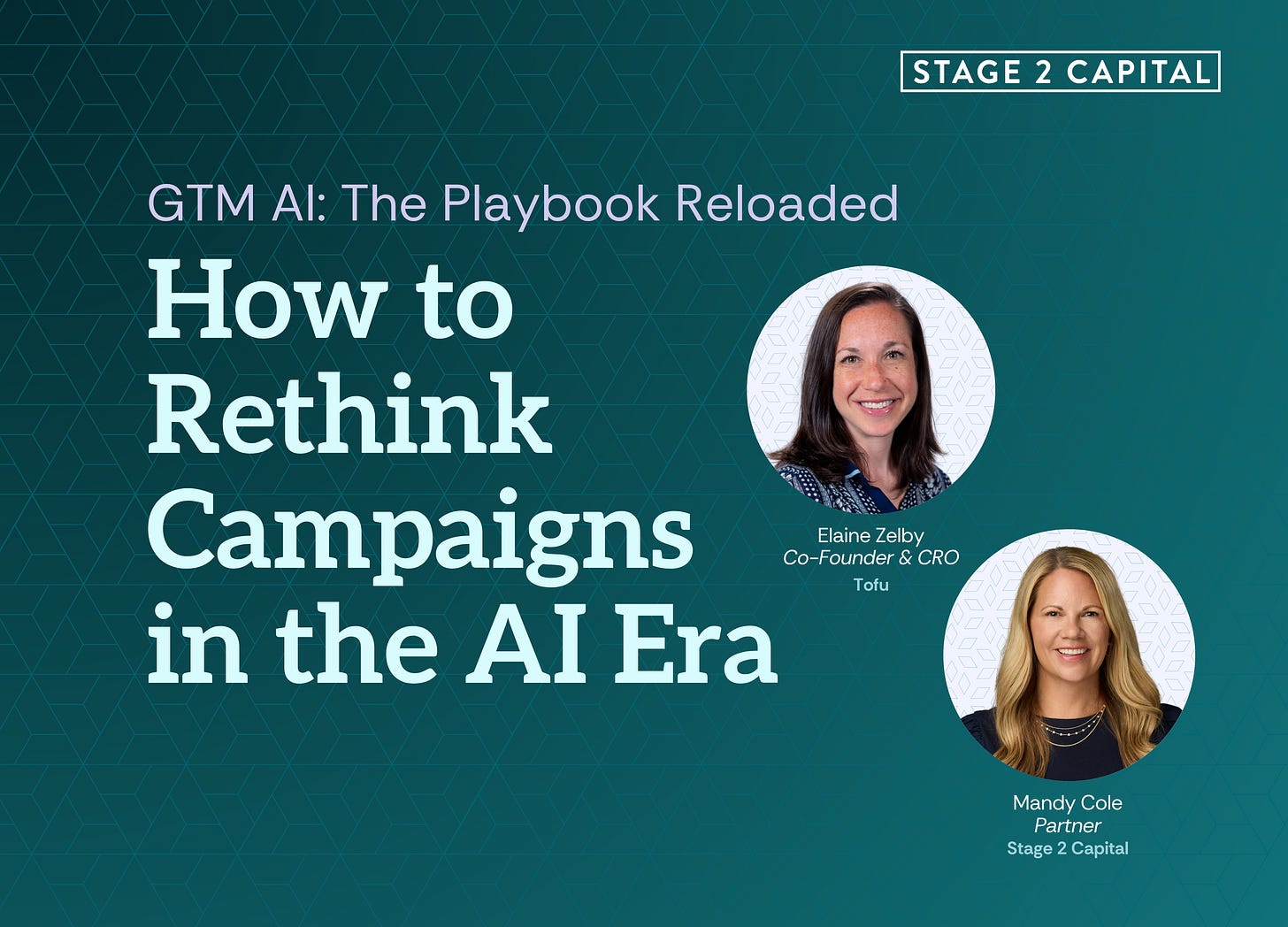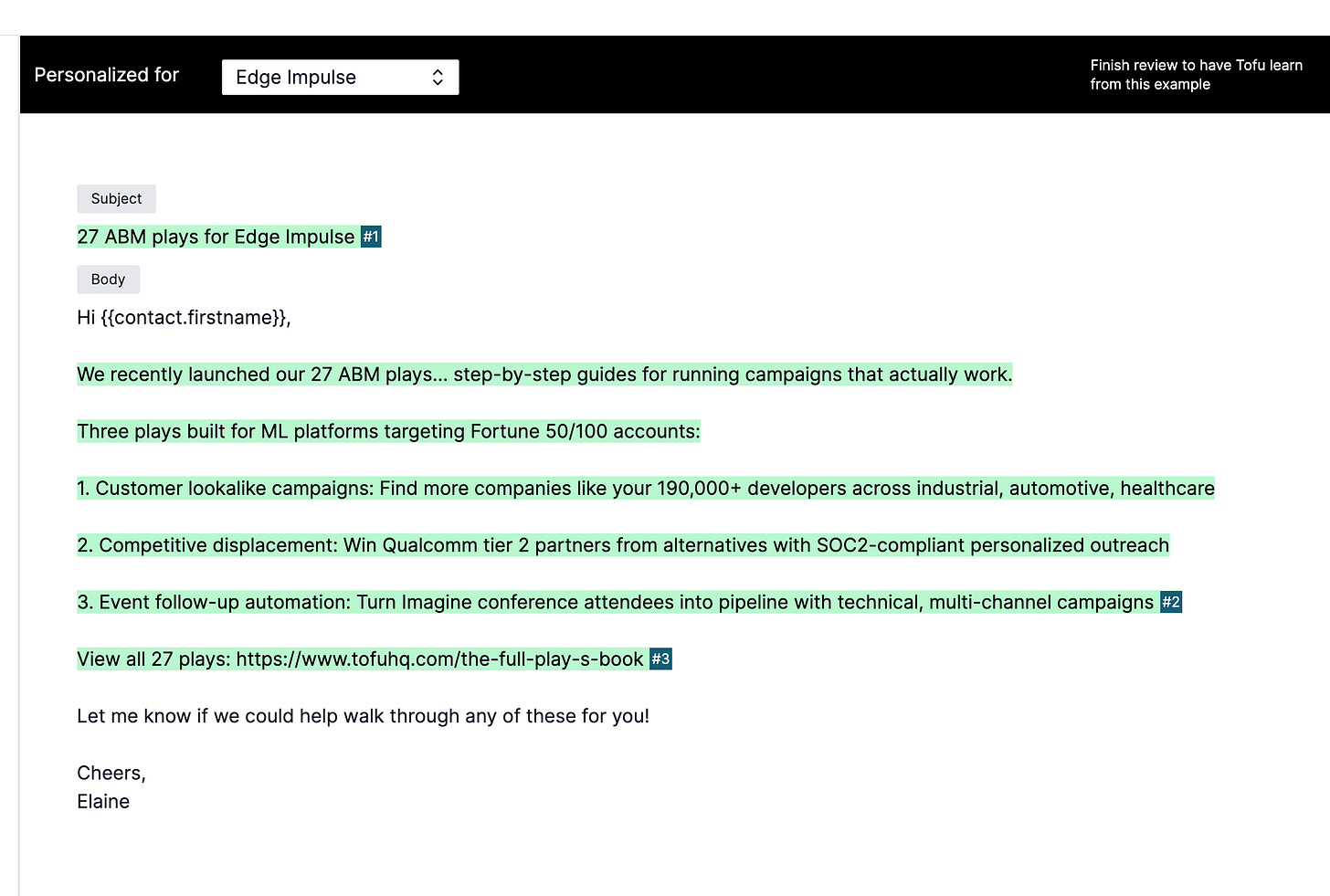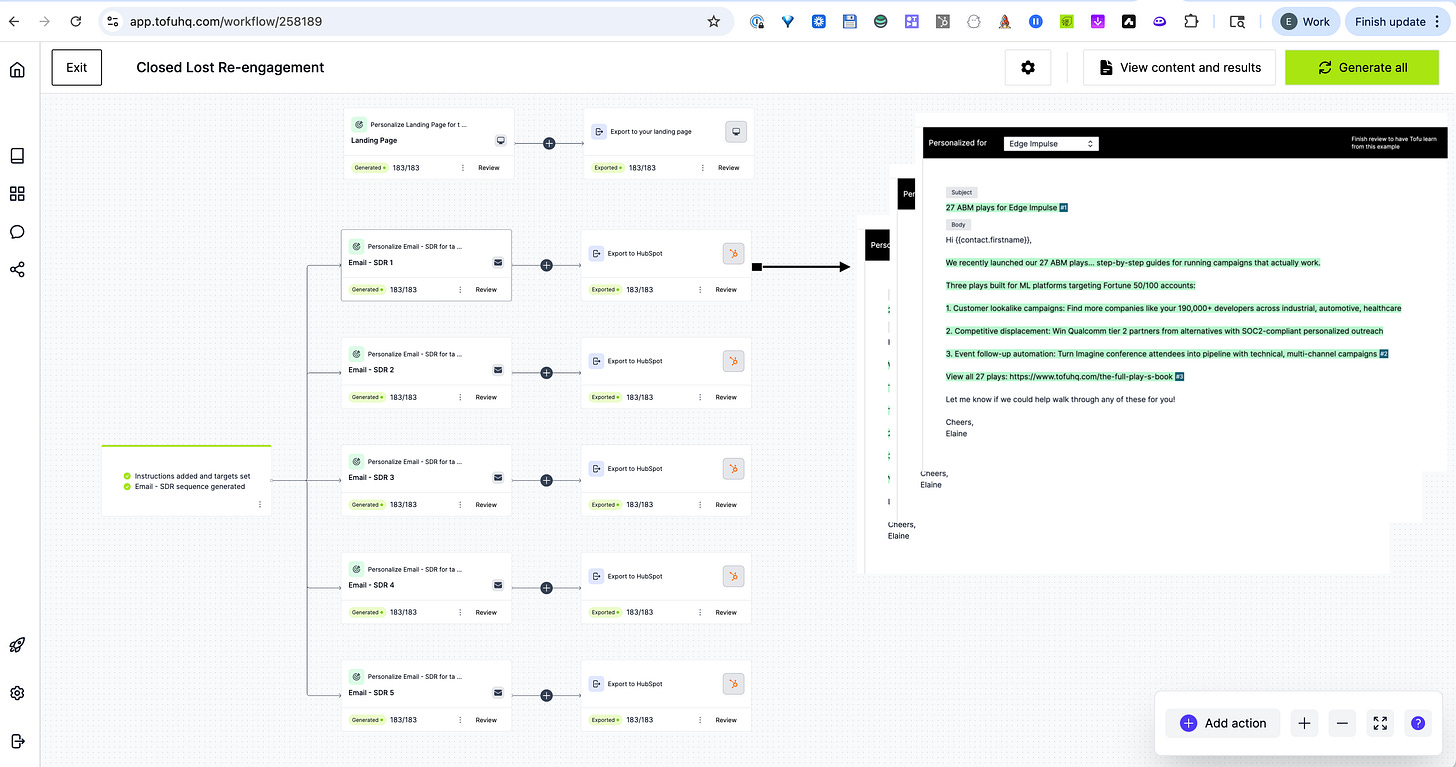How to Rethink Campaigns in the AI Era
A practical guide to using AI to scale smarter, more personalized marketing campaigns.
If you’re a marketing team of one at a SaaS or tech company, you know the daily math: big goals, small bandwidth. You’re expected to plan, launch, and measure multi-channel campaigns for different personas while juggling product launches, content calendars, and a founder’s next idea.
The good news is that AI is making it possible for a small team to market like a big one. The challenge is knowing how to use it and where it genuinely moves the needle.
I recently sat down with Elaine Zelby, Co-Founder and CRO of Tofu, a Stage 2 portfolio company, to explore how marketers are scaling campaigns in the AI era. Elaine’s approach is refreshingly grounded: use AI to multiply execution, not to replace strategy.
1. From “One-Size-Fits-All” to “One-Size-Fits-One”
“Everything is about relevance and context,” Elaine said. “Historically, marketing was one-size-fits-all. But really, one size fits one. That’s what marketing has always aspired to be, and now it can.”
For years, personalization meant little more than a {First Name} token in an email. Today, AI can tailor every asset, including emails, ads, decks, even landing pages, to an individual’s industry, behavior, and history with your brand.
In Tofu, a feature called Deep Research scans a company’s full catalog of marketing materials (case studies, webinars, call transcripts) to surface insights instantly. Imagine typing: “Find all case studies that focus on performance. List the customer, industry, quotes, and three highlights.”
Within seconds, it compiles the results. For a solo marketer, that’s days of research condensed into minutes, and a foundation for relevance that goes far beyond copy tweaks.
Even without a dedicated platform like Tofu, marketers with a shoestring budget can replicate this type of automated research using tools such as ChatGPT’s file-analysis and search capabilities.
Let’s say you have a folder of case studies, sales call transcripts, and webinar summaries, a typical mix for a lean SaaS marketing team. You could upload those files directly into ChatGPT and then prompt it:
“Search across all my uploaded materials and find every case study that mentions performance improvements as a key outcome. For each one, list:
The customer name and industry
The problem they solved
Any quantitative results (e.g., time saved, conversion lift, uptime)
Three notable quotes or takeaways.
In a few seconds, ChatGPT would extract that data across dozens (or hundreds) of documents and turn unstructured archives into a structured research report.
You could then follow up with iterative prompts to narrow your insights:
Of those performance-related case studies, which industries show the largest ROI gains?
Summarize how our messaging around performance has evolved between 2023 and 2025.
Pull exact customer quotes we could reuse in ad copy or sales decks.
Founder takeaway: Personalization isn’t about pandering; it’s about precision. The marketer who builds campaigns around context wins the next era of GTM.
2. AI Is Not a Strategy, It’s a Multiplier
Elaine’s biggest warning: “AI isn’t a migrator or a magic button; it doesn’t deliver strategy.”
AI can execute, but it can’t decide why your message matters. The human still defines the story; AI just turns it into 27 assets in the time it used to take to write one.
For example, Tofu can take a single messaging doc and instantly create:
A blog post
Three LinkedIn posts for different personas
A Google Ad set
A pitch deck
A personalized email sequence
Each variant respects your tone, structure, and brand rules. The marketer defines the direction; AI scales it across channels and formats.
Tofu can learn the tone of a specific person, for example, an executive’s LinkedIn voice. It analyzes sample posts (word choice, sentence rhythm, emoji use) and builds a reusable tone profile. The result: every social post sounds like that person actually wrote it, not like “AI wrote it for them.”
For cash-strapped founders, or marketers who want to test AI as a marketing multiplier, you can use this playbook with a free tool:
Step 1: Upload Your Core Messaging Document
Start with your value proposition doc, launch brief, or positioning statement. This could be a Google Doc that articulates:
Your core audience segments (e.g., DevOps engineers, marketing leaders, procurement)
Your problem statement and solution
Key differentiators and proof points
Upload that file into an AI tool and give it a clear command such as:
Use this messaging document to create the following assets for our upcoming product launch:
A 700-word blog post that explains the launch in plain language for existing customers.
Three LinkedIn posts: one targeting executives, one targeting technical users, and one for partners.
A Google Ad set with 10 responsive headlines and 4 descriptions.
A 6-slide pitch deck introducing the product to prospects.
Step 2: Generate Each Asset Type
Then, you can see how the AI tool will structure and output each deliverable in sequence, complete with section headers, tone adjustments, and platform formatting.
You can refine on the fly:
“Make the executive LinkedIn post more thought-leadership oriented.”
“Simplify the technical post to a 9th-grade reading level.”
“Reformat the pitch deck into a 5-slide investor-style deck with a single data point per slide.”
You can even ask for brand voice consistency:
“Match the tone to our existing posts: authoritative but conversational. No jargon.”
If you’ve previously uploaded sample posts or a brand guide, most AI tools can analyze those and emulate the same structure and language style (similar to TOFU’s “Tone Creation” feature).
Step 3: Package and Reuse
Once you’re happy with the results, ask the tools to bundle everything:
“Create a table summarizing these assets, their target persona, and recommended publication channel. Then export all text to a single Google Doc.”
You can also have it generate image prompts for your designer or an image-generation model:
“For each LinkedIn post, suggest a concept for a supporting image.”
Founder takeaway: Keep humans in charge of ideas; let AI handle the heavy lifting.
3. Start Small: Prove Impact Before You Scale
AI adoption shouldn’t start with a full-stack overhaul. Elaine recommends a proof-of-concept mindset. “You should always have a free trial before you buy,” she said. “Deeply identify the lowest-hanging fruit.”
Maybe that’s a closed-lost re-engagement campaign, one of the most avoided opportunities in SaaS. Marketers know they should run re-engagement campaigns, but if you have to choose between finding new leads and trying to engage people who have already said no, the new leads usually win out. But now that you can spin up a new campaign in an hour, marketers can do both.
For Elaine, closed-lost re-engagement is a great test case for Tofu’s Personalized Nurture flow:
Ingest call recordings to identify loss reasons
Generate a four-email nurture sequence that addresses those objections
Personalize the content by persona and company
Launch it automatically through HubSpot or Marketo
What used to take a week of coordination can now be done during a 30-minute demo call.
Another small-start idea: Database reactivation. Identify “high-fit, low-activity” leads, and run an AI-driven re-engagement sequence that references their last interaction.
Founder takeaway: The goal isn’t to automate everything. It’s to free yourself to focus on strategy by automating the 80% that repeats.
4. Expand Your Definition of ‘Campaign’
Executives often think of a “marketing campaign” as a series of LinkedIn posts or a blog article. Marketers have always known that a true campaign is a connected ecosystem of complementary assets.
Regardless of your preexisting notion of “campaign,” it’s time to think bigger. Even the most sophisticated marketing experts need to start viewing campaigns as assets that have the potential to adapt to every buyer interaction.
Case Studies from Calls: Upload a Zoom recording or transcript, and AI generates a case study following your brand’s template. It fills in missing details (headquarters, industry, metrics) from open sources, then writes narrative copy and quotes.
Decks from Webinars: Instead of manually building slides, upload the recording and let AI generate a presentation in your brand’s slide template, complete with key takeaways, graphics, and speaker notes.
Ads and Social Posts: Feed an eBook or whitepaper into the system, and it generates LinkedIn posts, Google Ads, and blog drafts that align with your brand voice and channel best practices.
Each of these use cases removes a bottleneck that previously required design, ops, or agency help.
Founder takeaway: The AI-powered campaign isn’t a collection of disconnected tasks. It’s a flywheel where research, creation, and execution all feed each other.
5. Personalization at Scale Is Finally Real
For years, account-based marketing was more of a pipedream than a reality: one-to-one experiences at scale. In practice, most teams settled for “one-to-few.” That’s changing.
One-to-One ABM Campaigns: With TOFU’s templates, a solo marketer can select target accounts from the CRM, personalize landing pages for each one, and auto-generate matching SDR email sequences and LinkedIn ads. The system uses existing brand templates and research data to populate industry-specific language and imagery.
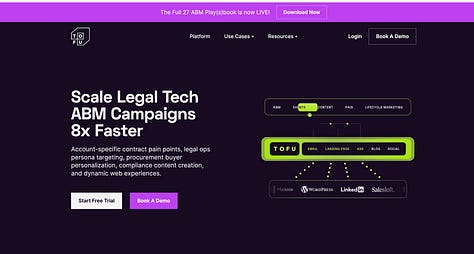
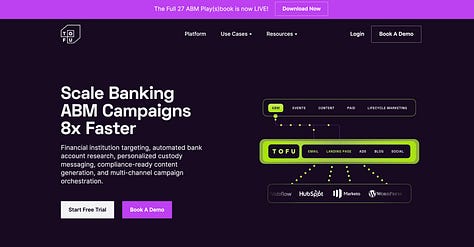
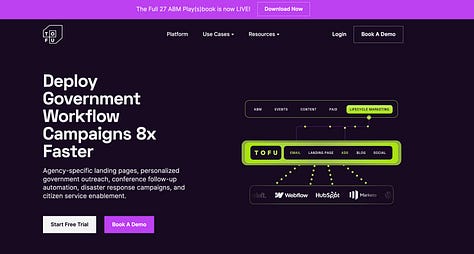
The result is a true end-to-end ABM workflow that connects every touchpoint, from personalized page to email to ad, without needing a team of specialists.
Founder takeaway: ABM is no longer reserved for enterprises. A marketing team of one can now build one-to-one campaigns in hours, not weeks.
6. AI Is Only as Good as the Data Behind It
Elaine often reminds teams that AI’s superpower is context, but only if you feed it enough of the right context.
Think of AI as a junior marketer who learns fast but starts blank. If you train it on the wrong assets or forget to update your inputs, its output will reflect those gaps.
That’s why Elaine advocates for centralizing your content repository. Whether you use a CRM, a CMS, or a shared drive, give AI access to call recordings, eBooks, case studies, and customer data. The more you connect those dots, the smarter your system becomes.
In Practice → Data Enrichment: Tofu automatically pulls firmographic and behavioral details from 12 datasets and pairs them with your CRM records. Ask it, “Which accounts host frequent webinars?” and it will crawl the web, cite sources, and generate a list for a targeted campaign.
Founder takeaway: Data is the fuel that makes AI marketing go. Keep it clean, connected, and current.
7. Carve Out Time to Play
The best AI marketers aren’t just using tools, they’re experimenting with them. Elaine recommends leaders “force the time to play.”
“Carve out dedicated, repeated time to kick the tires on tools. At least once a month,” she says. “Stuff is changing so quickly.”
Make AI practice a habit:
Host a monthly “AI lab day” where your team tests new prompts or models.
Assign someone to re-audit your best performing assets with AI assistance each quarter.
Capture and share your prompt templates internally,
AI won’t replace marketers, but marketers who don’t adopt AI thinking will get replaced by those who do.
Founder takeaway: Treat AI fluency like a muscle that will grow with practice.
8. How to Avoid the Next Wave of Shiny Objects
Elaine acknowledges the temptation to try every new AI tool. Her advice: “Focus on bigger tools that can do more things for more people on your team, the ones that get you 90% of the way there.”
The goal is to reduce tool fragmentation. Pick a few core platforms that integrate well and enable cross-team visibility. A lightweight stack might look like:
CRM + MAP: HubSpot or Salesforce for data and automation
AI Execution Layer: Tofu or equivalent for research → creation → distribution
Analytics Layer: Mixpanel or Looker for performance tracking
This stack keeps your team nimble while still giving you the benefit of AI scale.
Founder takeaway: Less software, more integration.
9. Reframing AI as Creative Leverage
Perhaps the biggest shift AI introduces isn’t efficiency but creative leverage. When you can generate assets in minutes, you can spend more time testing ideas.
The marketer who launches 10 mini experiments a week will outlearn the marketer who launches one big campaign a quarter.
AI lets you:
Turn a webinar into a deck in minutes
Build personalized landing pages for every target account
Launch and iterate ads with matching visuals and copy in real time
And it does so without adding headcount, just better thinking.
Founder takeaway: AI doesn’t erase your creative instincts; it amplifies them. Use that leverage to experiment fearlessly.
Final Thought: It’s Still About Strategy
The most important sentence from my conversation with Elaine Zelby was this: “AI doesn’t deliver strategy.”
That line stuck with me. Because underneath every tool, every automation, every algorithm, someone still has to decide what story we’re telling and why it matters.
If you start with a clear strategy and a point of view, AI becomes your multiplier. If you don’t, AI just helps you do the wrong thing faster.
So as you experiment with AI in your go-to-market motion, remember:
Campaigns are now systems. They learn and adapt.
The stack is flattening. The barrier to execution is dropping.
Strategy is still the moat. Your insight, creativity, and taste can’t be replicated.
The marketers who win the AI era won’t be the ones who buy every tool. They’ll be the ones who understand where AI ends and where their strategic judgment begins.



